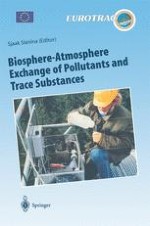1997 | Buch
Biosphere-Atmosphere Exchange of Pollutants and Trace Substances
Experimental and Theoretical Studies of Biogenic Emissions and of Pollutant Deposition
herausgegeben von: Prof. Dr. Sjaak Slanina
Verlag: Springer Berlin Heidelberg
Buchreihe : Transport and Chemical Transformation of Pollutants in the Troposphere
Enthalten in: Professional Book Archive
